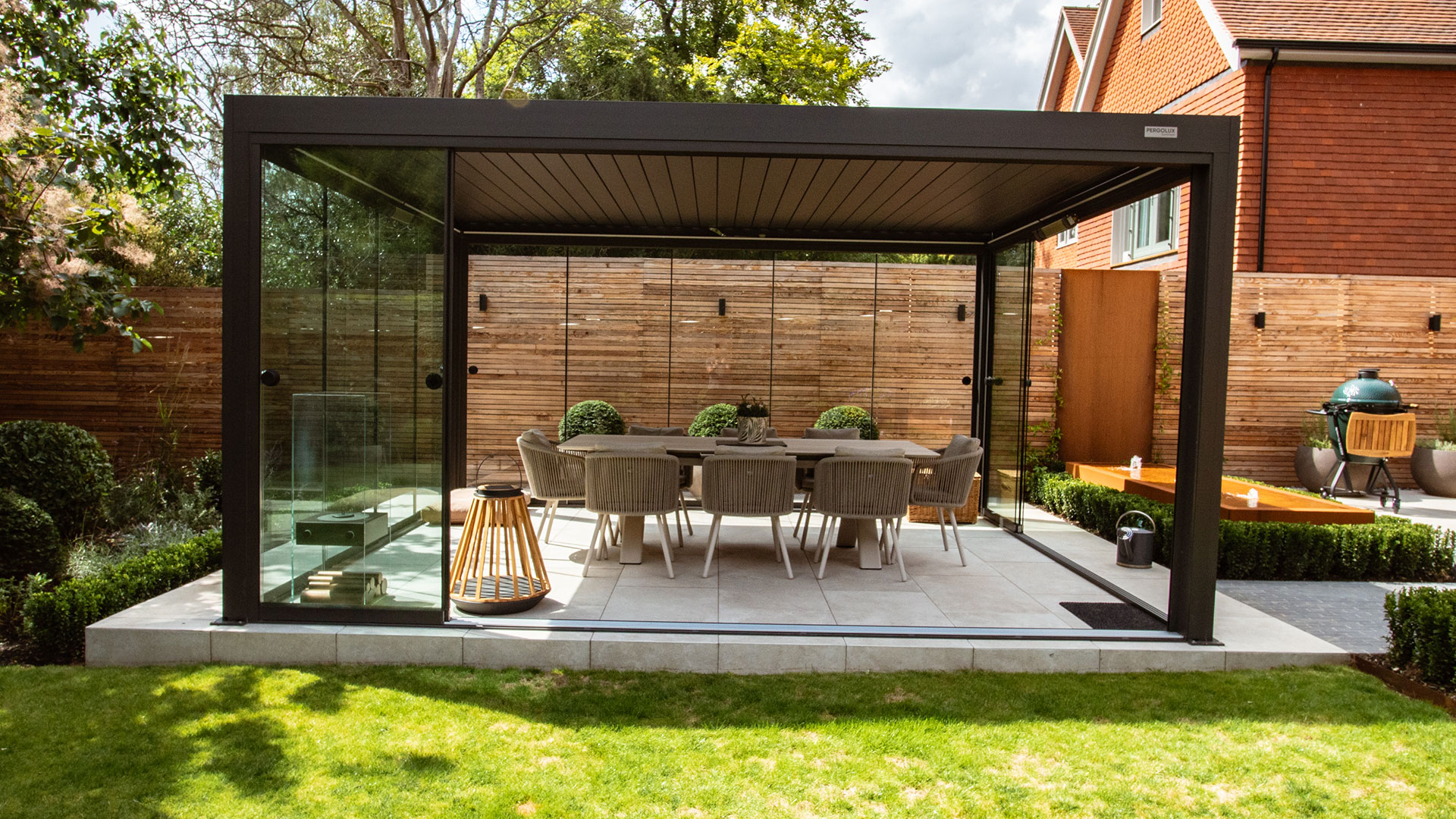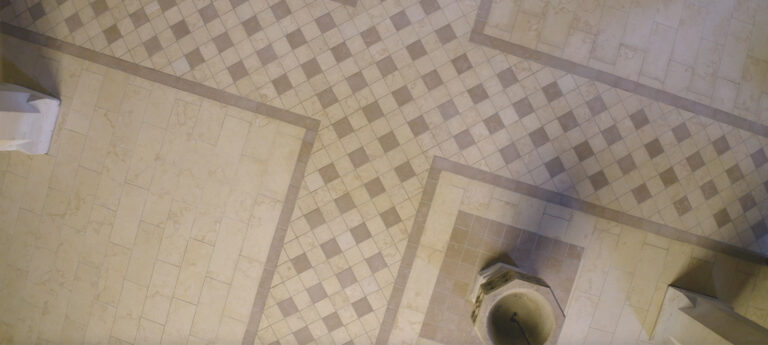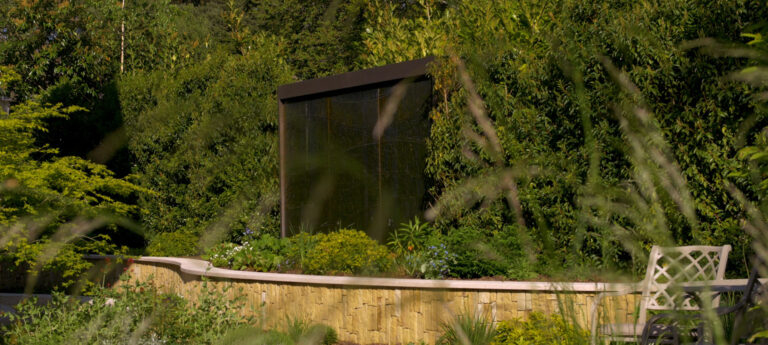There’s a lovely, and often nerve-wracking, moment in any major project. It’s the space between the final 3D visual and the first finished materials going into place. The design promises perfection, but the reality is yet to take shape and perhaps to far ahead to visualise. For the owners of this beautiful property just south of Winchester, that moment has passed. What has been created beyond that moment is far more compelling: a garden that doesn’t just meet the vision but breathes life into it and has genuinely changed how the property owners live.
Nine months ago, we documented the skeletal stages of this build—a landscape of potential, all soil and half-built walls. Today, we’re returning to walk through the fully realised space. This isn’t just a garden; it’s a series of elegant outdoor rooms, a seamless extension of the home designed for living, entertaining, and quiet contemplation.
The project, a design from the talented Joe Savage Garden Design and brought to life by the meticulous craftsmanship of Joe Irving and his team at Aurum Hortis, serves as a perfect case study in how to blend hard-wearing materials with soft, natural planting. At its heart are two key materials that form the very canvas of the space from us: dark, dramatic limestone pavers and clean, contemporary stone-inspired porcelain tiles.
The Blueprint: More Than Just a Patio – Live More Outside
Before a single paver was laid or footing dug, this garden existed as a series of intricate 3D visuals. Joe Savage didn’t just sketch out a layout; it told a story of how the space would be used.
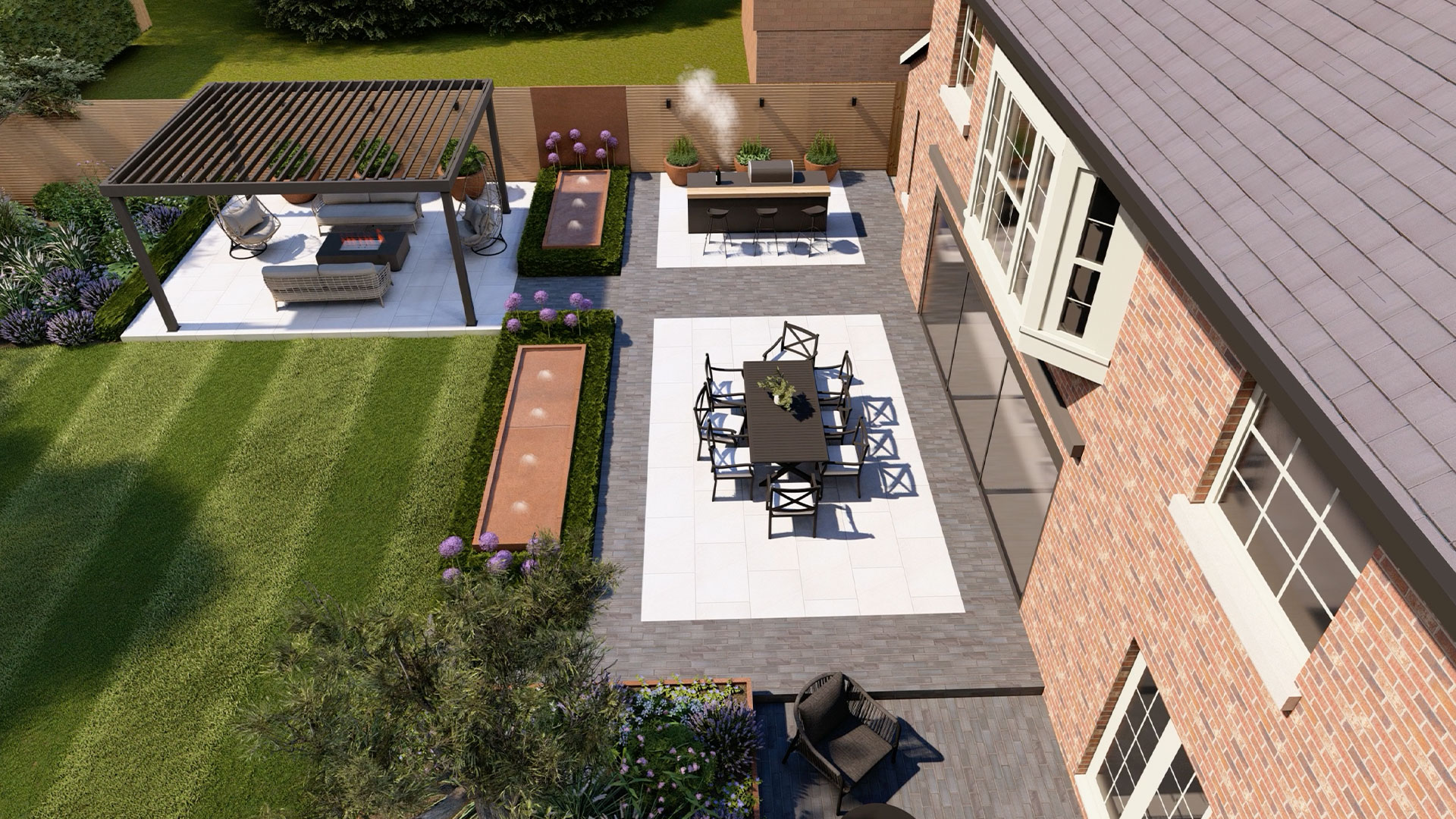
“Joe does a lot of 3D video & visuals,” says Joe Irving of Aurum Hortis, as we stand on the finished terrace. “That really, really helps with people… and from a construction point of view, it’s also really good to see the job from different angles.”
This approach moved the project beyond a simple 2D plan, allowing everyone—from the clients to the landscapers—to understand the intention behind every corner and step detail. The design intentionally carved out distinct zones:
-
The Entertaining Terrace: A spacious area centred around an outdoor kitchen by Winchester Outdoor Kitchens and a dining spot sheltered under a sleek, modern pergola.
-
The Dining Space: A separate, seating area with comfortable, grey-toned furniture under a pergola that invites lazy afternoons and alfresco dining.
-
The Private Courtyard: A more intimate space on the other side of the property, designed for morning coffee in a sunny, secluded spot.
This zoning is the first lesson in premium garden design: your garden should have a flow, and include rooms, much like the interior of your home.
The Material Palette: A Union Between Stone and Porcelain
The foundation of this design’s success lies in its material choices. The clients wanted a modern, low-maintenance space that felt both luxurious and connected to the house. The solution was a gorgeous contrast of texture and tone.
The Winsor Limestone Pavers: Structure and Drama
Underfoot, defining the main pathways and terraces, are the dark, richly textured Winsor Limestone Pavers. A choice like this is always a bold one.
“I must admit, when people go for a really dark, contrasting paver, I’m always a bit like… I wonder how that will look?” admits Forest Stone’s Craig, as he surveys the finished space. “And they’ve really pulled it off here. It’s beautiful.”
And they have. The dark pavers provide a grounding, architectural element. They create a strong framework that makes the green of the planting and the light tones of the furniture pop. This is the power of limestone cobbles; they offer a timeless, rugged beauty that feels both natural and intentionally designed. Their riven surface provides grip and character, ensuring the space is as practical as it is beautiful.
The Exbury White Porcelain Tiles: The Indoor-Outdoor Flow
Contrasting with the dark pavers are the elegant Exbury White Porcelain Tiles. Used in the courtyard and for the main seating and dining terraces, and even internally in a cleverly converted dog-grooming area, these tiles are the key to the garden’s clean, contemporary yet timeless feel.
“The beauty of these tiles,” Craig explains, “is you can get that real inside-outside flow. You can get exactly the same tile design for internal as you can for external.” This continuity is a game-changer for properties with large bi-fold or sliding doors, effectively making the garden another room of the house.
But not all Italian porcelain tiles are created equal. A key feature that sold the team on this particular product was its authentic stone-like appearance.
“Anyone who lays a lot of porcelain, you know that on some of the sort of lower-cost tiles, there’s only like six patterns on the tile,” notes Joe Irving. “It’s really easy to lay two or three of the same print together and it’s really obvious. Whereas on these, I think we’ve counted before, there’s like 14 or 15 different variations.”
This high degree of variation avoids the repetitive, “fake” look that can plague cheaper stone-inspired porcelain tiles. Furthermore, the tumbled edge porcelain tiles have a softly worn, slightly rounded edge that gives them a more natural, less harshly manufactured finish than a straight, rectified edge. This subtle detail is crucial for achieving a look that feels organic and high-end.
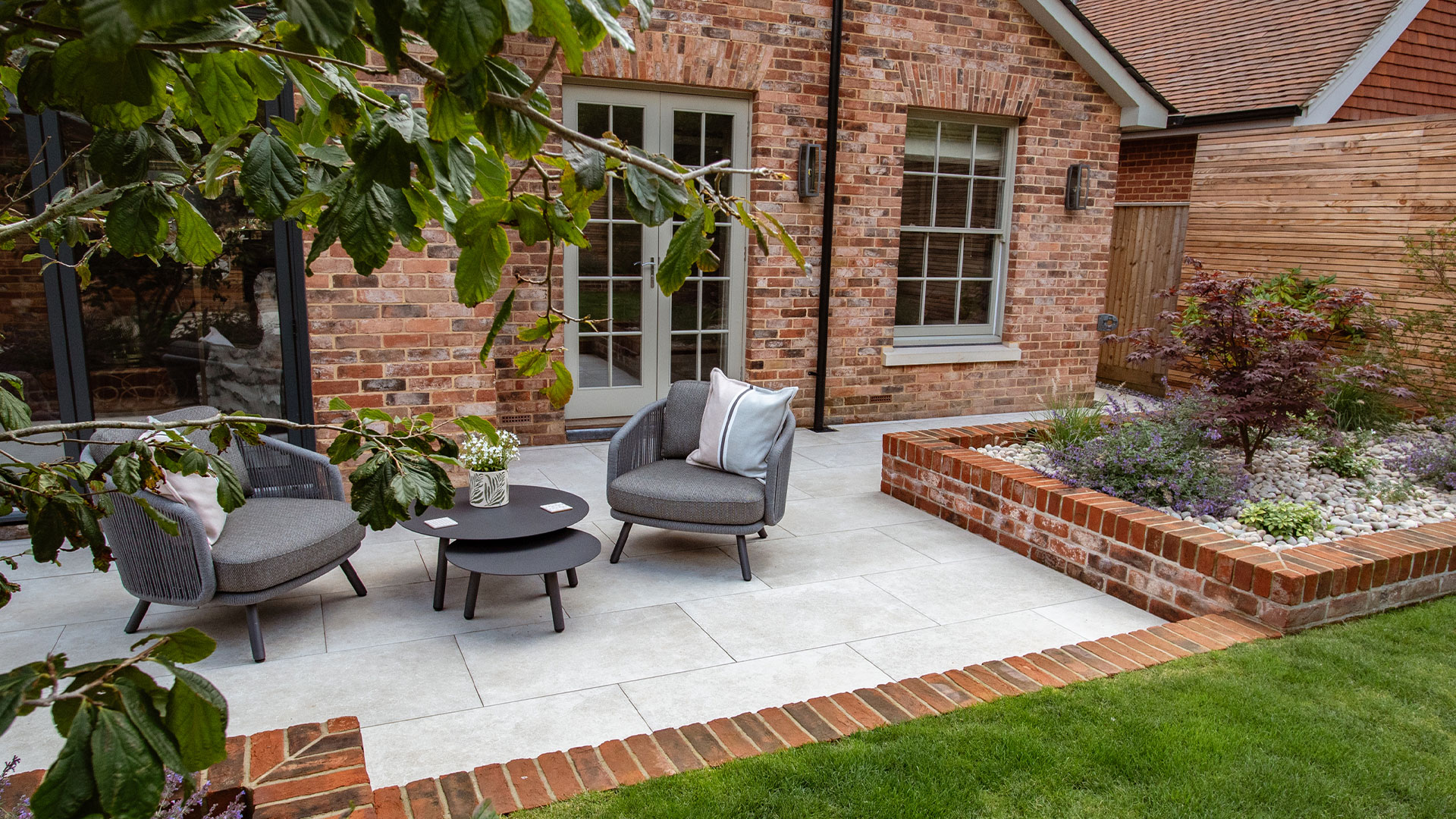
The Art of the Detail: Where Craftsmanship Shines
A premium garden is defined by its details. It’s in the elements that you might not notice immediately, but whose absence would make the entire space feel less cohesive.
One such detail is the “wrap-around” step, where the tumbled edge porcelain tiles flow seamlessly over the top and down the face of a step, meeting the lawn below on the pergola terrace. It’s a mitred corner that shows a level of care and skill.
“It doesn’t take that much longer to do,” says Joe, “but it just improves the visual of the job tenfold.”
Another technical triumph on this project was the grouting. Using a light-toned grout on dark stone is a notoriously tricky task, as it can lead to unsightly white efflorescence or haze. The Aurum Hortis team’s meticulous method—using FlowPoint grout with precise water ratios and a slow, careful washing-up process—resulted in a flawless finish.
“If you rush to get it in, or use too much water in the process” Joe warns, “there can be efflorescence and haze… it’s really difficult to get off.” This commitment to getting the small things right is what separates a good garden from an award-worthy one.
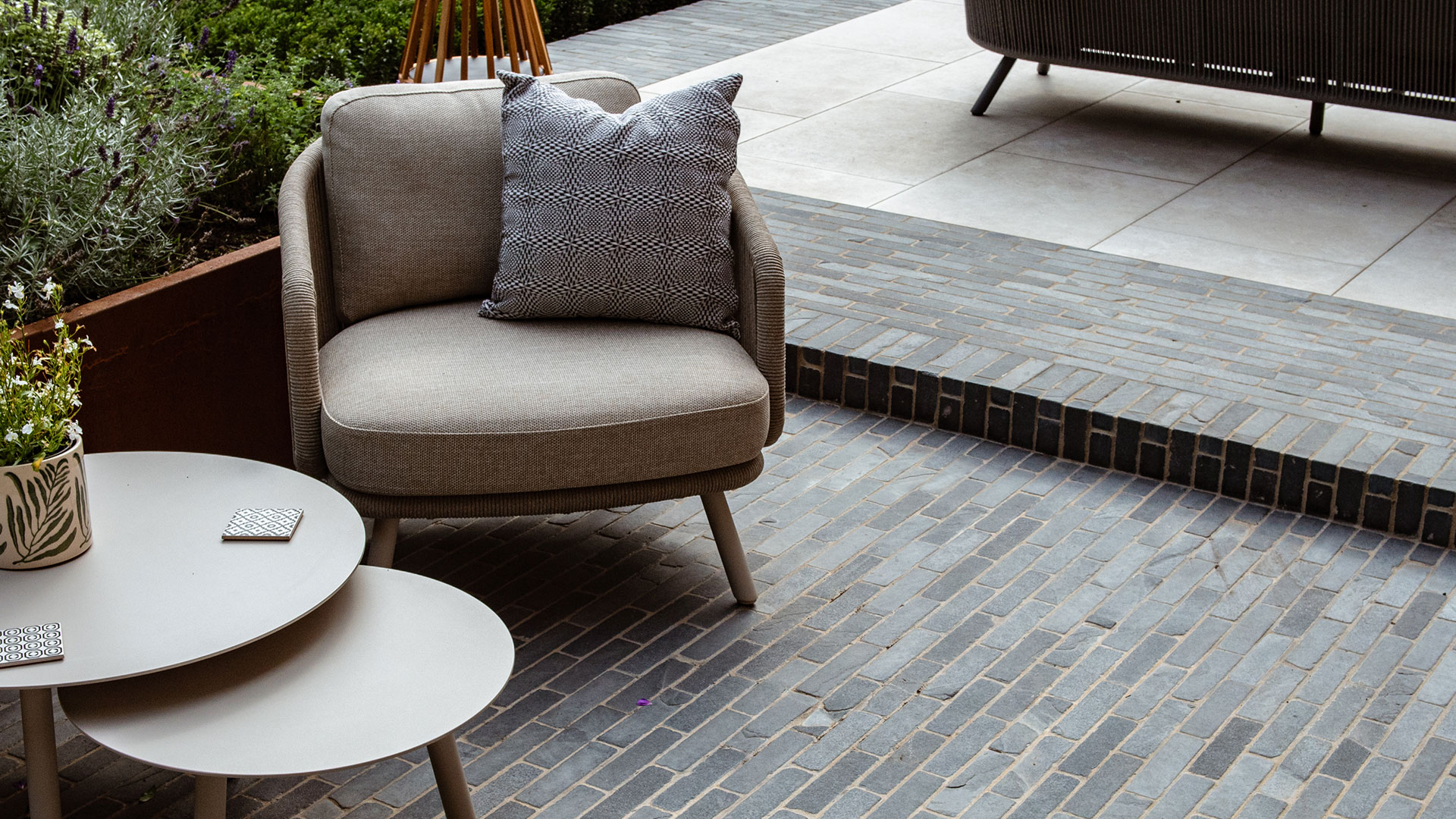
Beyond the Build: A Garden That’s Actually Used
The ultimate test of any garden design is not how it looks in photos, but how it feels to live in. The most compelling feedback from this project came directly from the homeowners.
“The clients have said that they literally spend more time out here than they do inside,” Joe Irving shares with a smile. “And that’s a common theme on a lot of projects for us.”
This is the real return on investment. The garden has been transformed from a basic, “bare bones” space into the heart of the home. With a weatherproof pergola, an outdoor kitchen, and multiple seating areas, it’s a space that functions from morning coffee to evening entertaining, regardless of the forecast.
Why Seeing is Believing: The Power of a Display Garden
A recurring theme in our conversation was the challenge of visualisation. How do you choose between a dark limestone paver and a light stone-inspired porcelain tile from small samples?
This is where our display gardens become invaluable. The clients for this project visited the Forest Stone displays in Nursling, Southampton, to see the materials laid out in a real-life context.
“Your yard’s got a lot of what has ended up on this project… it’s got the pergola, it’s got a little water feature, loads of other little things that you would have in your garden next to the paving choices,” Joe Irving explains. “It’s really, really handy. People can come and they can actually look properly, see what these things look like in context.”
Unlike a builder’s merchant where samples are crammed together with irrelevant garden materials adjacent to each other, a fully planted display garden allows you to walk on the surfaces, see how the light hits them at different times of day, and understand how they work together with complimentary materials as a cohesive whole. It’s a really helpful tool to aid landscaping material selections.
A Legacy in Stone and Porcelain
Walking through the completed garden, there’s a palpable sense of pride from everyone involved. It’s a project that showcases the perfect alignment of client vision, designer creativity, and landscaper skill. The materials—the robust Winsor Limestone Pavers and the sophisticated Exbury White Porcelain Tiles—were not just chosen for their individual beauty, but for how they work with the other materials and the home they surround.
“I’m really proud of this one,” Joe Irving concludes, with the quiet satisfaction of a job well done. And so he should be. This garden is more than a collection of plants and paving; it’s a testament to the idea that our outdoor spaces are not separate from our homes, but a vital extension of them. It’s a lesson in how flow can be created from space to space, and how a well-executed design can fundamentally change how you live.
See the Full Story Unfold
Want to experience every detail of this stunning transformation? Watch our full feature film, where Forest Stone’s Craig talks through the garden with Joe Irving of Aurum Hortis. They delve deeper into the design choices, the challenges, and the craftsmanship that brought this space to life.



